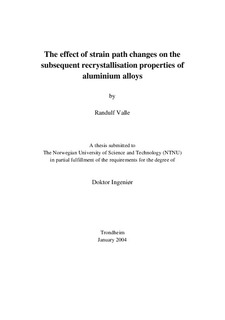| dc.contributor.author | Valle, Randulf | nb_NO |
| dc.date.accessioned | 2014-12-19T13:24:58Z | |
| dc.date.available | 2014-12-19T13:24:58Z | |
| dc.date.created | 2004-03-10 | nb_NO |
| dc.date.issued | 2004 | nb_NO |
| dc.identifier | 123426 | nb_NO |
| dc.identifier.isbn | 82-471-6220-2 | nb_NO |
| dc.identifier.uri | http://hdl.handle.net/11250/248709 | |
| dc.description.abstract | A study of strain path related effects on recrystallisation in aluminium has been carried out. The recrystallisation process has been studied after deformation in torsion and one pass hot rolling. For both deformation models, the work has been a combination of experimental studies of the deformation microstructure and recrystallisation process, as well as use of models for prediction of the deformation- and recrystallisation process.
For deformation in torsion AA1050 and AA3103 has been studied. Cyclic deformation to zero net strain resulted in restoration of the initial grain structure, while monotonic deformation yielded an increasingly more elongated grain structure. Studies by EBSD revealed no difference in subgrain size as function of strain path, but the subgrain misorientation was larger after monotonic deformation. Similarly, the distance between high angle boundaries was smaller after monotonic deformation. The recrystallised grain size was larger after cyclic deformation, compared to monotonic deformation to the same cumulative strain. In AA1050 the difference in recrystallised grain size was mainly sees as an effect of difference in grain boundary area, leading to fewer nuclei after cyclic deformation. A small difference in driving pressure also contributed to the difference in recrystallised grain size. In AA3110 an additional effect of weakening of deformation zones surrounding particles was purposed, resulting in lower density of PSN-nuclei after cyclic deformation and accordingly larger grain size.
The experimental study of the hot rolling pass was performed on an AA3103 alloy. A slight increase in Vickers hardness was seen from center to surface of the rolling slab after deformation. The microstructure after rolling was predicted by a combination of FEM-simulations and a microstructure model. This approach resulted in a larger predicted gradient in flow stress through thickness than calculated from the hardness measurements. The recrystallisation kinetics were monitored and were found to be fastest in the surface areas. The experimentally measured gradient in recrystallisation kinetics from center to surface was much larger than what was modeled. This was seen as an effect of the models limited coverage of changes in the density of nuclei as a result of other mechanisms than a difference in the driving pressure. | nb_NO |
| dc.language | eng | nb_NO |
| dc.publisher | Fakultet for naturvitenskap og teknologi | nb_NO |
| dc.relation.ispartofseries | Doktoravhandlinger ved NTNU, 1503-8181; 2004:10 | nb_NO |
| dc.subject | Materials science | en_GB |
| dc.subject | TECHNOLOGY: Materials science | en_GB |
| dc.title | The Effect of Strain Path Changes on the Subsequent Recrystallisation Properties of Aluminium Alloys | nb_NO |
| dc.type | Doctoral thesis | nb_NO |
| dc.source.pagenumber | 225 | nb_NO |
| dc.contributor.department | Norges teknisk-naturvitenskapelige universitet, Fakultet for naturvitenskap og teknologi, Institutt for materialteknologi | nb_NO |
| dc.description.degree | dr.ing. | nb_NO |
| dc.description.degree | dr.ing. | en_GB |
